“The French Connection”
Harp Ensemble
Friday, April 17, 2015
3-3:30 p.m.
Performance by:
Rosalie Boyle, Christian Sumprer, Frances Welsh, and Pat Wooster
“The French Connection”
Harp Ensemble
Friday, April 17, 2015
3-3:30 p.m.
Performance by:
Rosalie Boyle, Christian Sumprer, Frances Welsh, and Pat Wooster
 Data-Planet Statistical Datasets: Now with 100% More IMF
Data-Planet Statistical Datasets: Now with 100% More IMF
University of Puget Sound recently gained access to International Monetary Fund (IMF) data through our database Data-Planet Statistical Datasets. Puget Sound students, staff, and faculty members will now be able to access IMF data through the Statistical Datasets Portal including balance of payments, direction of trade, government finance statistics, and international financial statistics.
Economist Jokes
Recently the contributors to NPR’s Planet Money, Robert Smith and David Kestenbaum, documented their attempt to do 3-minutes of stand-up comedy comprised entirely of economics jokes at a New York comedy club on an episode of the Planet Money Podcast. Given the subject matter, and their inexperience (this was the first time either had done stand-up) it’s not surprising that they bombed.
Smith and Kestenbaum’s attempt at economist humor is hardly the first or most successful. Yoram Bauman, aka the Stand-Up Economist is making a career out of combining economics and comedy. He performs economic-themed comedy across the country at a variety of venues including colleges and professional conferences, and has authored two cartoon introductions to economics.
Check out his bit below called Mankiw’s Ten Principles of Economics Translated from the AAAS humor session from 2007.
By Ben Tucker
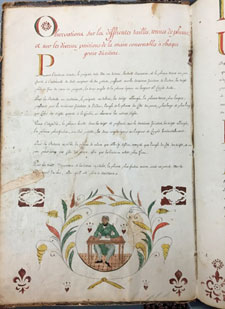 Rarely do I come across a book that is as physically beautiful as the words inside. I usually read a book because the story is intriguing or wonderful. But those books are just words on a page. While I was looking through the Archives & Special Collections today, I came across a book that is way more than words. The book, Tours d’Arithmetique by Jean Louis Bernard, was created by Bernard for his studies in 1809. Every page is a work of art. Even the script is remarkable. I sat there totally absorbed in its complexity. You can still see the pencil marks that allowed him to make straight lines. Could you imagine if books today were treated with such focus and detail? In the Archives & Special Collections you can find such pieces!
Rarely do I come across a book that is as physically beautiful as the words inside. I usually read a book because the story is intriguing or wonderful. But those books are just words on a page. While I was looking through the Archives & Special Collections today, I came across a book that is way more than words. The book, Tours d’Arithmetique by Jean Louis Bernard, was created by Bernard for his studies in 1809. Every page is a work of art. Even the script is remarkable. I sat there totally absorbed in its complexity. You can still see the pencil marks that allowed him to make straight lines. Could you imagine if books today were treated with such focus and detail? In the Archives & Special Collections you can find such pieces!
Open Tuesdays, Wednesdays, and Thursdays from 1:00-3:00 pm.
By Sierra Scott
 My Drunk Kitchen includes recipes, stories, full color photos, and drawings to inspire your own culinary adventures in tipsy cooking. It is also a showcase for Hannah Hart’s great comedic voice. Hannah offers key drink recommendations, cooking tips (like, remember to turn the oven off when you go to bed) and shares never-before-seen recipes. If you consider yourself to be a “foodie”, don’t miss out on this great cookbook!
My Drunk Kitchen includes recipes, stories, full color photos, and drawings to inspire your own culinary adventures in tipsy cooking. It is also a showcase for Hannah Hart’s great comedic voice. Hannah offers key drink recommendations, cooking tips (like, remember to turn the oven off when you go to bed) and shares never-before-seen recipes. If you consider yourself to be a “foodie”, don’t miss out on this great cookbook!
Spotlight on Archives & Special Collections –
A focus on “hands on” learning
The Archives & Special Collections hold a wealth of material including university records, rare books from the 16th – 20th centuries, artists’ books, and manuscript collections. Sessions in the Archives & Special Collections are hands on, experiential learning opportunities which provide students with the chance to evaluate and interpret primary source evidence, hone their research and critical thinking skills, and develop an appreciation for the intrinsic value of primary source material.
A great example of the type of learning experiences offered by Collins librarians is a session for Art History 276: Studies in Western Art II: Renaissance to Modern Art . This class met in the Archives & Special Collections to learn how to evaluate images from texts as well as understand the differences between images found through academic databases and Google Images.
At the beginning of the session students worked in pairs to evaluate images and decorations found in 16th through 18th century rare books and asked to assess how the image related to the text, the source of the image, and the intent of the artist. Student groups shared their findings with the larger class, discussing how to evaluate an image when the text is in a language the student could not read and identifying the purposes of an image by determining the intended audience for the text.
Students were then assigned a specific image and using both ARTstor and Google Images, evaluated the quality of the image and the information available through each source. The class then discussed the importance of analyzing the quality of an image and when it is appropriate to use one tool or the other.
After the session, Professor Linda Williams commented: “Both parts of the class session were really illuminating (no pun intended) and got them thinking about how images communicate, the value of archival material, and tools for finding and looking at digital works. I was so pleased that a number of the points you made were things I can reinforce in class or have introduced in a tangential way.”
If this type of assignment is intriguing, please consult with your liaison librarian or contact Katie Henningsen, Archivist and Special Collections Librarian directly.
Need Information? Don’t forget the Collins Memorial Library – Library Guides
Questions? Contact your liaison librarian
Comments: Contact Jane Carlin, library director
Remember – Your best search engine is a librarian!
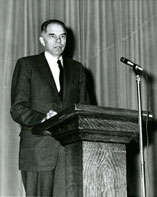 If you’ve ever glanced over the table of elements in the past thirty years or so, you might be familiar with the name “seaborgium.” Turns out, the namesake of that element, Glenn T. Seaborg, was actually a speaker here at our very own Diamond Jubilee in 1963! A Diamond Jubilee is the 75th anniversary of a thing – if you might recall, we had our 125th anniversary back in 2013. Seaborg’s speech had some pretty interesting predictions for the future (as scientists love to make crazy predictions), some of which were right, some of which were wrong.
If you’ve ever glanced over the table of elements in the past thirty years or so, you might be familiar with the name “seaborgium.” Turns out, the namesake of that element, Glenn T. Seaborg, was actually a speaker here at our very own Diamond Jubilee in 1963! A Diamond Jubilee is the 75th anniversary of a thing – if you might recall, we had our 125th anniversary back in 2013. Seaborg’s speech had some pretty interesting predictions for the future (as scientists love to make crazy predictions), some of which were right, some of which were wrong.
For example, he predicted that nuclear power was going to be the forerunner for the production of electricity by 2038, and now that it’s 2015, nuclear power still only accounts for 11% of the world’s electricity. It comes in fourth after coal (40%), gas (23%), and hydroelectric (17%), and it’s unlikely that nuclear will overtake any of these three any time soon, but with 20 years of research and advancing technologies, I suppose it’s still possible. Seaborg’s other predictions included nuclear-powered rockets, manned bases in space, and communication satellites. Humorously enough, he calculated that the entire world would only need three communications satellites to handle coverage of the entire world – according to ucsusa.org we have 1,235 communications satellites in orbit. I mean, it’s only a small difference compared to three.
Seaborg also apparently said, “to keep peace with the scientific age our educational system must produce men and women who are knowledgeable in science.” This certainly hasn’t changed as a fact in the past 52 years, and likely won’t any time soon. But I suppose we’ll see how his predictions hold up by the time our sesquicentennial (that’s a 150th anniversary) rolls around!
You can always see pictures of the Diamond Jubilee, read Seaborg’s entire prediction, or learn more about other speakers and celebrations we’ve had at the University of Puget Sound if you stop into the Archives & Special Collections on Tuesday, Wednesday, and/or Thursday between 1:00-3:00 p.m.!
By Morgan Ford
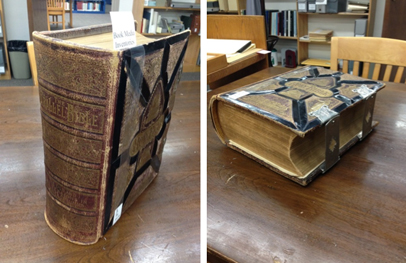 Do not be fooled by this book’s description! It may say the “Holy Bible” on the cover, but the truth of its ulterior motives is hidden in the spine—it is a “parallel bible.”
Do not be fooled by this book’s description! It may say the “Holy Bible” on the cover, but the truth of its ulterior motives is hidden in the spine—it is a “parallel bible.”
If you’ve never heard of parallel bibles, it’s probably because the government has been doing a fantastic job of keeping them a secret from the general public. Fear not! We have acquired one of these tomes for your languid perusal. Should you choose to browse through this very large, very heavy specimen, you will find that pages from the well-known bible of our own dimension is situated on the right hand page, while on the opposite (left) page there lies something else entirely—a bible with ideas totally apart from our own, ideas and morals from another dimension, that is very aware of us, and is very clearly observing us. While the language still appears to be English, there are subtle differences between the two that lead scholars to believe that one is derived from the other–however the connection still remains unclear to this day. It is likely that the language we wish to claim as our own is actually a derivative of this parallel dimension’s primary method of communication.
This book of comparisons and detailing of parallels is highly detailed, with an intricate binding and clasps on the outside to warn passersby away from its radical ideas, and thousands of gold-gilt pages filled with careful studies and comparisons in the margins. Even the art in the preface of the book–surprisingly similar to our own dimension’s medieval art–is carefully annotated. It is unclear whether the purpose of this parallel bible is to copy us as a species or to compare their pre-existing culture to our own.
We probably acquired this book in a shady deal over a game of chess with a government scholar, who probably acquired it from a questionable area of influence.
You can read some decrypted government files on the subject of parallel bibles and their possible contents here or here, or you could stop in to the Archives & Special Collections and see what sort of extradimensional secrets you can glean from its pages for yourself.
“the best kind of comedy is flagrant lies and nonsense, delivered deadpan and seriously.” (rosaluxmemeburg)
Al-Mutanabi Street is the historic center of the book universe in Iraq’s capital city of Baghdad. It is a street lined with booksellers and has served as the intellectual and literary hub of the city since the 8th century.
Now it has its first women bookseller, 22-year old Ruqaya Fawziya. She says:
In the beginning not only my family, anyone I would speak to about my idea to sell books at Al-Mutanabi Street, would oppose the idea, describing it as strange, and advising me not to do it, but later, when they saw me entering this world, they started encouraging me
I didn’t face any harassment from the people who visit Al-Mutanabi Street, but sometimes people look at me with a surprise look on their faces because they are not familiar with the sight of a woman selling books on the street. But there are many people who, on the contrary, encourage me
Read more of the online Book Patrol article, Al-Mutanabi street, Baghdad’s book row, gets its first female bookseller.
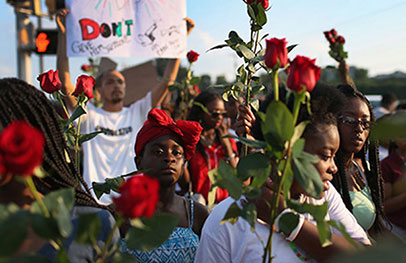
Demonstrators hold up roses while protesting the shooting death of Michael Brown on Aug. 18, 2014, in Ferguson, Missouri.
Nancy Bristow, History, African American Studies.
April 7, 2014
4 p.m.
Archives & Special Collections area,
2nd Floor, Collins Library
Asked in August, 2014, whether the shooting of Michael Brown in Ferguson, Missouri “raises important issues about race that need to be discussed,” 80% of African Americans said “yes,” while 47% of white Americans believed “race is getting more attention than it deserves.” These statistics make visible the divergent historical memories of two American communities and the powerful erasure silence around race makes possible. Focusing on the police shootings that took place at Jackson State College forty-five years ago, Professor Nancy Bristow will situate the recent events in Ferguson and beyond in the nation’s long history of state violence against African Americans and will explore the white community’s persistent unwillingness to acknowledge and address its racial dynamics.
Part of the Behind the Archives Door series!
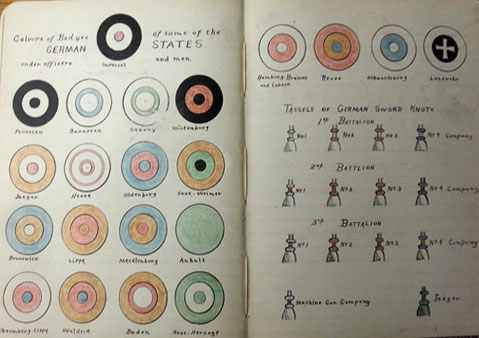 Today I decided to revisit a manuscript notebook that I first came across over the summer, when we initially acquired it. The Howard W. Robbins diary is a WWI notebook (1917-1918) which features 88 pages of handwritten notes, diagrams, formulas, and reports including the above illustrations of the various “Colours of Badges of some of the German States,” and the “Tassels of German Sword Knots.”
Today I decided to revisit a manuscript notebook that I first came across over the summer, when we initially acquired it. The Howard W. Robbins diary is a WWI notebook (1917-1918) which features 88 pages of handwritten notes, diagrams, formulas, and reports including the above illustrations of the various “Colours of Badges of some of the German States,” and the “Tassels of German Sword Knots.”
Robbins was a first Lieutenant in the 104th Infantry of the U.S. army, and his notebook features advice on a variety of topics, including Patrolling and Scouting, which, Robbins writes “is a great protection from surprise, serves to keep up the morale of our own troops, and tends to lower that of the enemies!” Robbins even includes a diagram for training soldiers in patrolling and scouting.
One of the most interesting aspects of Robbins’ notebook is his writings about the use of various military technologies, including Telescopes, the Prismatic Compass, Thermometer Targets, and even Aeroplane Photographs, or the taking of photographs from the air. This would have been an especially important new technology, as WWI was one of the first military conflicts to utilize powered aircraft. Robbins notes that those who take photos from the air are “men of special aptitude, as for instance artists, painters, architects, and so forth.” He also writes about how these photos help officers to identify German trenches, as well as Posts and Company Headquarters.
The notebook is filled with a variety of information on many different topics and could be a valuable and engaging primary source for anyone interested in WWI, or the development of military technologies and strategies.
Discover this and other interesting primary sources Tuesdays, Wednesdays, and Thursdays from 1:00-3:00 p.m. in the Archives & Special Collections on the second floor of the Library!
By Kara Flynn